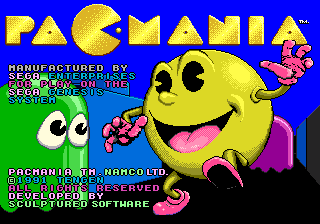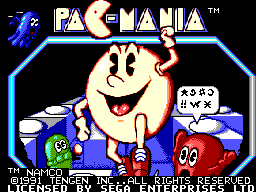Pac-Mania is a sequel to Pac-Man, first released in 1987 in the arcades by Namco for its Namco System 1 hardware and brought to the Sega Mega Drive and Sega Master System by Tengen in 1991. It has also been ported to numerous other consoles and computers, including the Amiga, Amstrad CPC, Atari ST, Commodore 64, MSX, NES, Zeebo and ZX Spectrum. It is a pseudo-3D take on the Pac-Man gameplay formula, though offers many other additions.
Gameplay
The game is presented in an oblique perspective with more detailed backgrounds than in previous Pac-Man arcade games. The disadvantage of this is that only a section of the play area is visible and therefore there is more of a reliance on scrolling. To counter this, Pac-Man now has the ability to jump, which can be used to avoid ghosts (apart from ghosts that can also jump). There are more ghosts on-screen than in previous titles too, who are found in a variety of different colors and are left unnamed. Unlike the original game there are now four maps, one of which is unlockable and each having their own music track.
History
Legacy
Though Pac-Mania was seen as a return to form for the Pac-Man franchise (previous entries such as Super Pac-Man, Pac & Pal and Pac Land had radically changed the original formula and were therefore not as successful), the game failed to receive the popularity obtained by the original Pac-Man or Ms. Pac-Man, mostly because despite appearing in 1987, it failed to offer much improvement over the original 1980 game.
Production credits
Mega Drive version
- Programmed by: Arti Haroutunian
- Artwork by: Lorin Nelson
- Sounds by: Paul Webb
Source: In-game credits
Master System version
- Converted by: Steve Lamb, Dan Duncalf, Simon Freeman, Jeff Gamon, and Muffy Vashele at TecMagik Inc, Menlo Park, California, U.S.A.
- August—October 1990
Source: EU manual[11]
Magazine articles
- Main article: Pac-Mania/Magazine articles.
Promotional material
- Main article: Pac-Mania/Promotional material.
Physical scans
Mega Drive version
| {{{{{icon}}}|L}}
|
Division by zero.
|
Based on
0 review
|
| Mega Drive, US
|
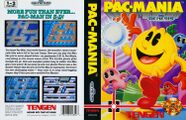 Cover
|
 Cart |
| Mega Drive, EU
|
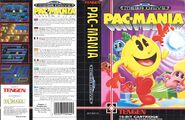 Cover
|
 Cart  Manual |
| Mega Drive, PT
|
 Cover
|
 Cart |
| Mega Drive, SE (rental; Hent; black)
|
 Cover
|
|
|
Master System version
| {{{{{icon}}}|L}}
|
Division by zero.
|
Based on
0 review
|
| Master System, EU
|
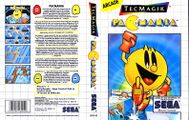 Cover
|
 Cart  Manual |
| Master System, PT
|
 Cover
|
|
|
| Master System, BX†
|
 Cover
|
|
|
| Master System, AU (Wide hotline sticker)
|
 Cover
|
  Cart |
| Master System, AU (Short hotline sticker)
|
 Cover
|
  Cart |
Technical information
- Main article: Pac-Mania/Technical information.
References
- ↑ File:PacMania SMS EU Box.jpg
- ↑ GamePro, "June 1991" (US; 1991-xx-xx), page 40
- ↑ Sega Pro, "February 1992" (UK; 1992-01-16), page 7
- ↑ Computer Trade Weekly, "" (UK; 1992-02-17), page 15
- ↑ ACE, "January 1992" (UK; 1991-12-08), page 91
- ↑ New Computer Express, "27th July 1991" (UK; 1991-07-25), page 50
- ↑ File:SouthWalesEcho UK 1991-08-03 Page 12.jpg
- ↑ Computer Trade Weekly, "" (UK; 1991-07-01), page 6
- ↑ 9.0 9.1 ACE, "May 1991" (UK; 1991-04-08), page 71
- ↑ Sega Power, "March 1991" (UK; 1991-02-07), page 11
- ↑ File:PacmaniaSMSEUManual7L.pdf, page 4
- ↑ 1700 igr dlya Sega, "" (RU; 2001-xx-xx), page 172
- ↑ ACE, "December 1991" (UK; 1991-11-08), page 91
- ↑ Consoles +, "Novembre 1992" (FR; 1992-1x-xx), page 124
- ↑ Console XS, "June/July 1992" (UK; 1992-04-23), page 132
- ↑ Game Power, "Marzo 1992" (IT; 1992-0x-xx), page 62
- ↑ Games-X, "16th-22nd January 1992" (UK; 1992-01-16), page 23
- ↑ Game Informer, "December 2001" (US; 2001-1x-xx), page 115
- ↑ Hobby Consolas, "Octubre 1992" (ES; 1992-xx-xx), page 134
- ↑ Joystick, "Janvier 1992" (FR; 199x-xx-xx), page 120
- ↑ Sega Mega Drive Advanced Gaming, "January 1993" (UK; 199x-xx-xx), page 93
- ↑ Mega Play, "July/August 1991" (US; 1991-0x-xx), page 64
- ↑ MegaTech, "Xmas 1991" (UK; 1991-12-06), page 38
- ↑ Mean Machines, "December 1991" (UK; 1991-11-28), page 62
- ↑ Mean Machines Sega, "October 1992" (UK; 1992-09-xx), page 140
- ↑ Player One, "Mars 1992" (FR; 1992-03-10), page 67
- ↑ Sega Power, "February 1992" (UK; 1992-01-02), page 48
- ↑ Sega Pro, "December 1991" (UK; 1991-11-21), page 48
- ↑ Sega Pro, "April 1993" (UK; 1993-03-11), page 66
- ↑ Supersonic, "Mai/Juin 1992" (FR; 1992-xx-xx), page 11
- ↑ Tricks 16 bit, "Tricks Sega Gold 800 igr" (RU; 1998-03-20), page 133
- ↑ VideoGames & Computer Entertainment, "November 1991" (US; 1991-1x-xx), page 42
- ↑ Aktueller Software Markt, "August/September 1991" (DE; 1991-07-26), page 159
- ↑ The Complete Guide to Sega, "" (UK; 1991-05-xx), page 116
- ↑ Console XS, "June/July 1992" (UK; 1992-04-23), page 143
- ↑ Computer & Video Games, "April 1991" (UK; 1991-03-16), page 60
- ↑ Mean Machines: The Essential Sega Guide, "" (UK; 1993-11-18), page 148
- ↑ Game Mania, "May 1993" (UK; 1993-xx-xx), page 81
- ↑ Game Power, "Gennaio 1992" (IT; 199x-xx-xx), page 42
- ↑ Games-X, "8th-14th August 1991" (UK; 1991-08-08), page 40
- ↑ Hobby Consolas, "Octubre 1991" (ES; 1991-xx-xx), page 72
- ↑ Joypad, "Janvier 1992" (FR; 1991-12-1x), page 88
- ↑ Joystick, "Juin 1991" (FR; 1991-0x-xx), page 138
- ↑ Micromanía (segunda época), "Noviembre 1991" (ES; 1991-1x-xx), page 44
- ↑ Mean Machines, "March 1991" (UK; 1991-03-01), page 54
- ↑ Mean Machines Sega, "October 1992" (UK; 1992-09-xx), page 135
- ↑ Player One, "Juillet/Août 1991" (FR; 1991-xx-xx), page 38
- ↑ Power Play, "5/91" (DE; 1991-04-12), page 130
- ↑ Raze, "August 1991" (UK; 1991-06-27), page 27
- ↑ Sega Power, "March 1991" (UK; 1991-02-07), page 10
- ↑ Sega Power, "October 1991" (UK; 1991-09-05), page 58
- ↑ Sega Pro, "March 1992" (UK; 1992-02-20), page 20
- ↑ Sega Pro, "April 1993" (UK; 1993-03-11), page 71
- ↑ Sega Force, "April 1992" (UK; 1992-03-19), page 52
- ↑ Video Games, "1/91" (DE; 1991-03-27), page 77
- ↑ Video Games, "2/92" (DE; 1992-04-06), page 33
- ↑ Zero, "June 1991" (UK; 1991-0x-xx), page 70
- ↑ Zzap!, "Giugno 1991" (IT; 1991-xx-xx), page 55
